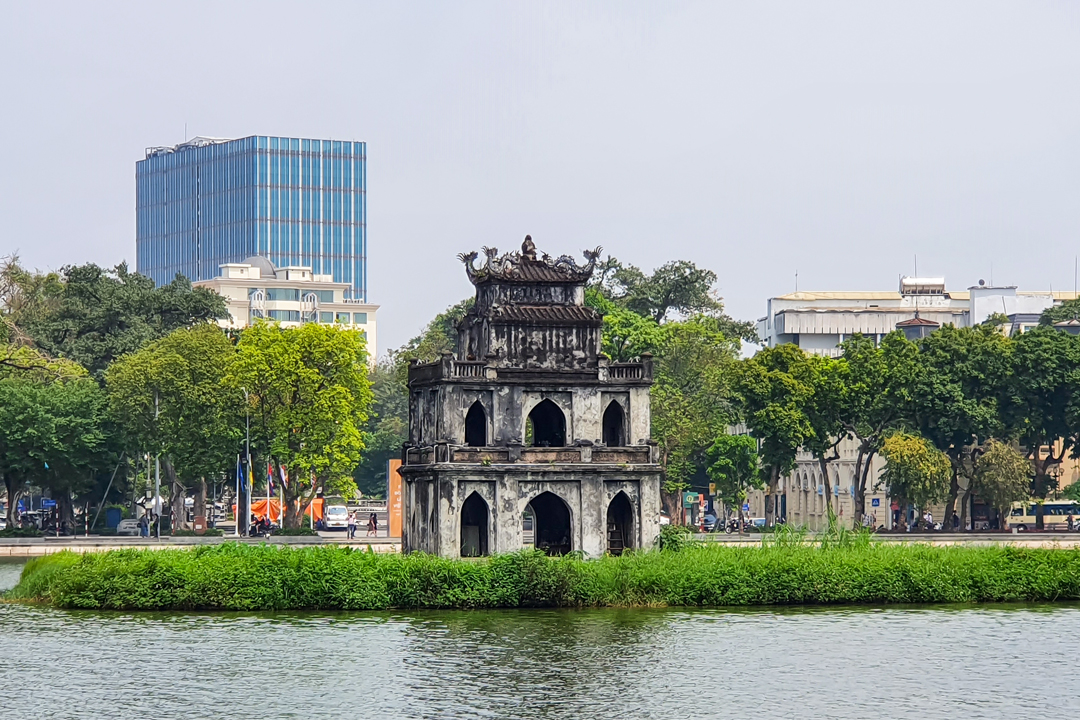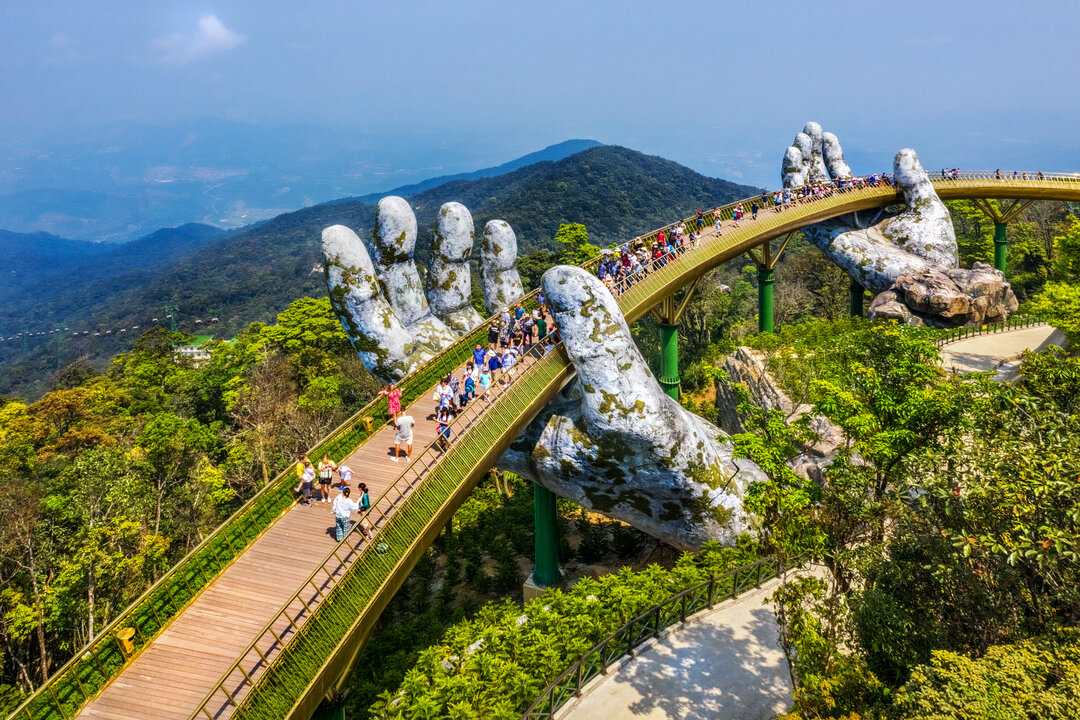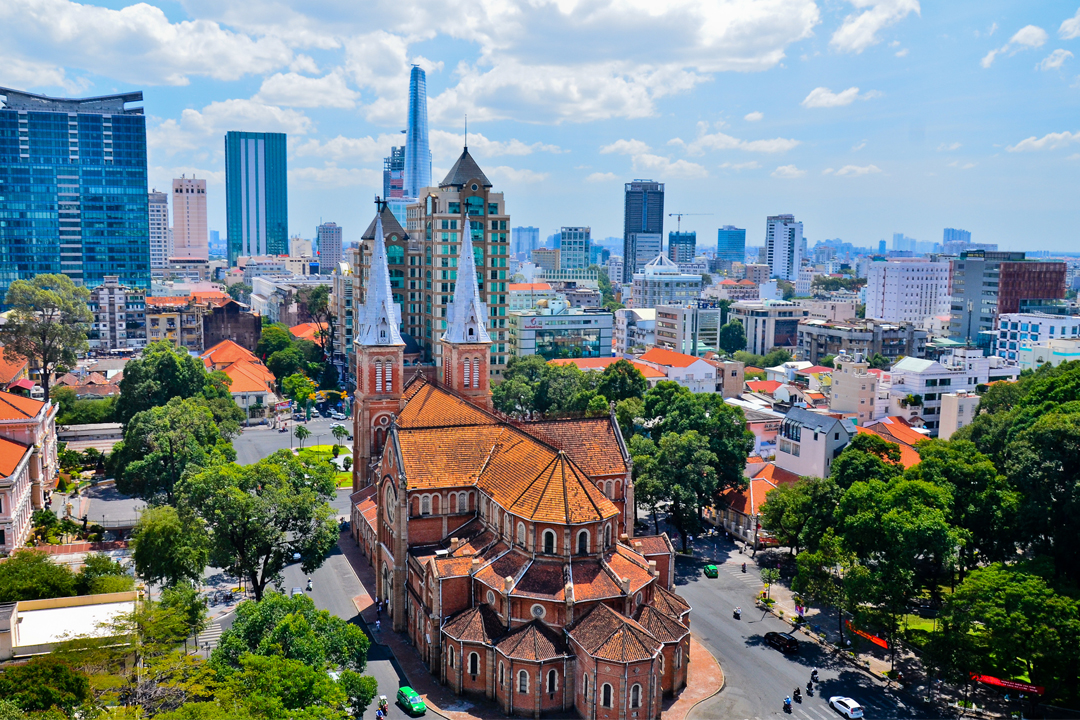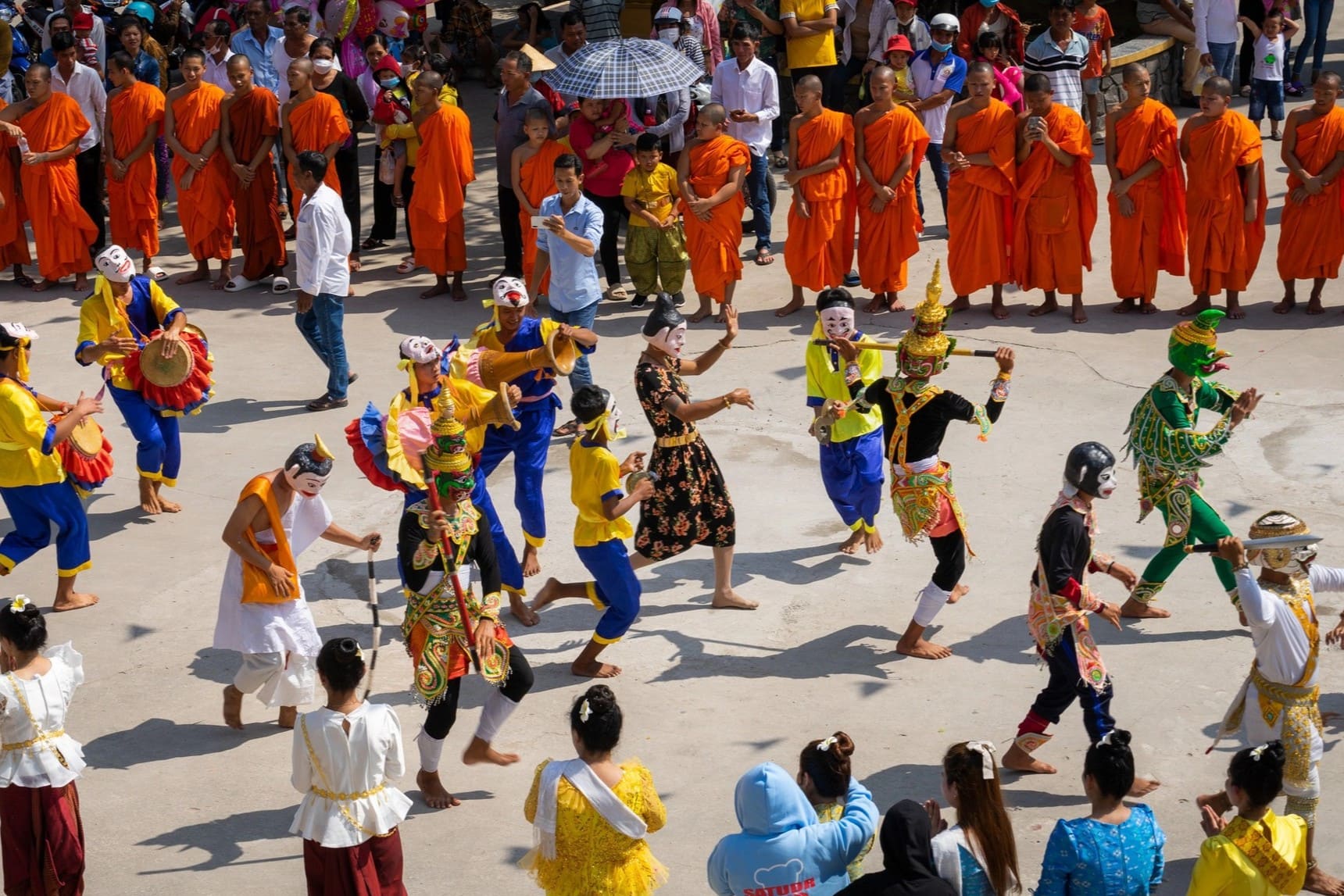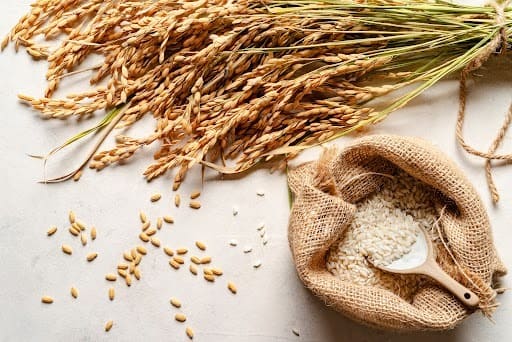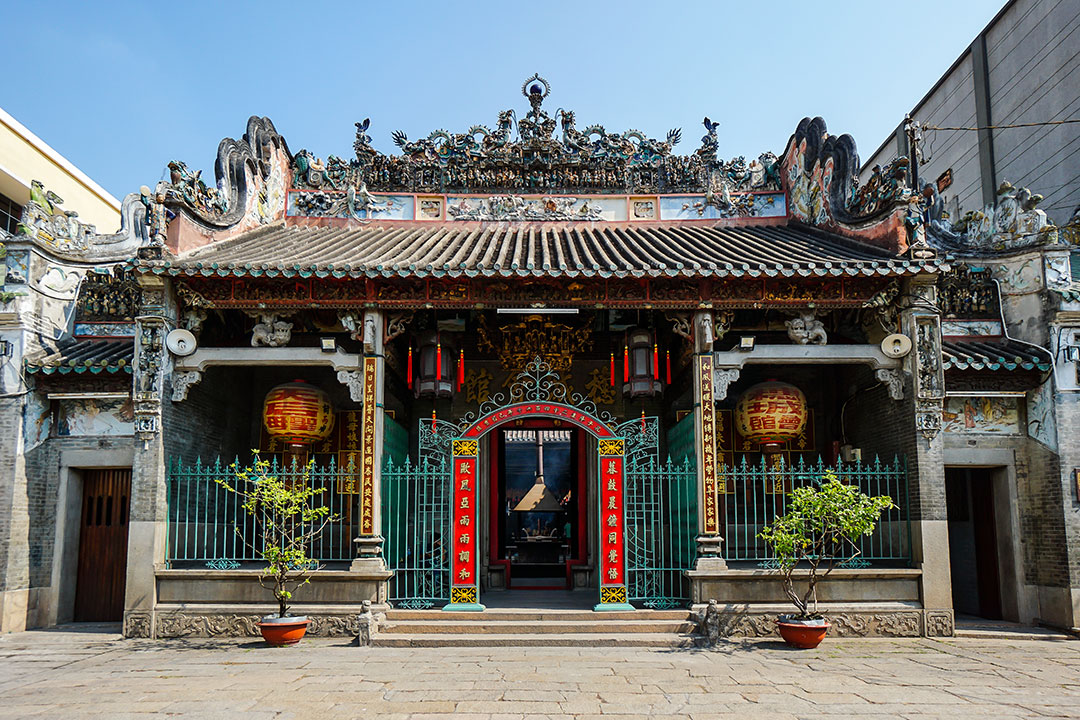Thien Hau Pagoda: History, Architecture & Travel Guide
Thien Hau Pagoda is a cultural landmark that opens a window into the vibrant Chinese–Vietnamese heritage of Ho Chi Minh City. For travelers seeking blessings, meaningful traditions, or a glimpse into local history, understanding the significance of this temple dedicated to Mazu is essential. Enriching the journey with GTrip, visitors can fully appreciate how the pagoda’s ornate architecture and sacred atmosphere reflect Vietnam’s unique blend of spiritual traditions.
Overview about the Thien Hau Pagoda
- Address: Located at 710 Nguyen Trai Street, Cho Lon Ward (formerly Ward 11, District 5), Ho Chi Minh City
- Opening hours: 6:00 AM - 11:30 AM & 1:00 PM - 4:30 PM (daily)
- Entrance fee: Free
Thien Hau Pagoda is one of the most significant spiritual landmarks in Ho Chi Minh City, known for its deep Chinese–Vietnamese heritage and dedication to the sea goddess Mazu. Visitors come to admire its centuries-old architecture, detailed wood carvings, and incense-filled courtyards that create a serene and sacred atmosphere. The pagoda is especially lively during traditional festivals, offering an authentic glimpse into local culture and community beliefs.
The history of Thien Hau Pagoda
Thien Hau Pagoda is one of the oldest and most culturally significant temples in Vietnam. More than just a place of worship, it is a living chronicle of the Chinese community’s deep-rooted presence and influence in southern Vietnam. Since its 18th-century founding, Thien Hau Pagoda has symbolized enduring faith, artistry, and community resilience.
Origins and founding in the 18th century
Thien Hau Pagoda was built around 1760 by the Chinese community. These early settlers brought with them cultural and spiritual traditions. The pagoda was dedicated to Mazu, the sea goddess revered for protecting sailors a fitting choice for early Chinese seafarers in Vietnam.
Architecturally, Thien Hau Pagoda was constructed following traditional Chinese temple design principles, embracing intricate artisan craftsmanship. Over the years, the structure has become synonymous with the dynamic history of the Chinese-Vietnamese populace, reflecting evolving architectural trends while maintaining its historical authenticity. The pagoda's initial founding illustrates the integration of Chinese architectural brilliance into the Vietnamese landscape. This establishment phase marked the pagoda as a crucial hub for spiritual and communal solidarity among Chinese immigrants facing the challenges of diaspora.
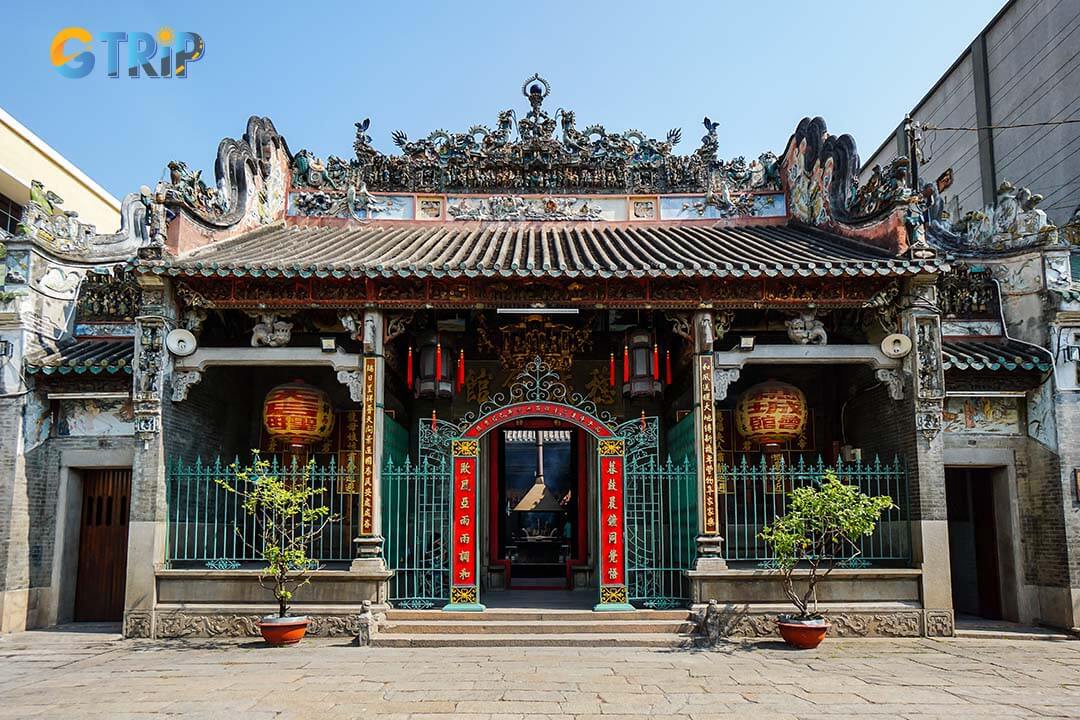
Thien Hau Pagoda is a historic spiritual site honoring the sea goddess Mazu and showcasing traditional Chinese architecture in the heart of District 5
Influence of the local Chinese community
The local Chinese community has profoundly shaped the trajectory of Thien Hau Pagoda, embedding it as a linchpin in social and cultural activities over the centuries. As a place of worship dedicated to Mazu, it has provided spiritual solace and a community meeting spot for generations. The pagoda evolved into an epicentre for various cultural events, acting as a touchstone for rites of passage, traditional festivals, and community decision-making gatherings.
The Chinese community played a pivotal role in the pagoda's founding and ensured its continued growth and relevance. Through community-led initiatives, they renovated and expanded the pagoda in phases, integrating features such as the large incense coils that have become emblematic of the temple ambiance. This involvement keeps the temple alive, meeting spiritual needs while honoring Chinese heritage through detailed carvings and tile work.
The pagoda serves as a bridge between the past and the present, demonstrating the symbiotic relationship between cultural preservation and community identity. Indeed, the temple's endurance and prosperity underscore the Chinese community's commitment to its cultural roots while adapting to the evolving socio-political tapestry of Vietnam.
Preservation efforts and modern-day relevance
In modern times, Thien Hau Pagoda faces the dual challenge of preservation and adaptation. The temple is now recognized as an invaluable cultural heritage site, attracting thousands of visitors annually. Efforts to preserve the pagoda's historical and architectural integrity have been undertaken by both local authorities and community organizations. These include restoring wood carvings and roof tiles to withstand Vietnam’s humid climate.
The pagoda remains an active religious site while welcoming growing interest from scholars, tourists, and spiritual seekers. It also plays a key role in cultural tourism. Maintaining this balance requires careful updates that respect its original essence and sacred atmosphere.
Furthermore, Thien Hau Pagoda remains a vibrant stage for annual festivals, most notably the Thien Hau Festival. It showcases traditional music, lavish processions, and incense rituals. These events, deeply rooted in history, offer profound insights into the harmonious blend of spiritual devotion and cultural practices. The pagoda today symbolizes continuity, manifesting how heritage sites can adapt yet remain rooted in time-honored traditions.
In conclusion, the history of Thien Hau Pagoda is not merely a narrative of architectural and religious significance, it is a story of cultural resilience and community spirit. We provided the origins in the 18th century to its current status as a cultural landmark, the pagoda encapsulates the enduring legacy of the Chinese community in Vietnam. The temple's ongoing preservation efforts ensure that it continues to thrive as a beacon of cultural heritage and religious faith in a rapidly modernizing world.
Architectural and decorative features
Thien Hau Pagoda, an emblematic Chinese temple in Ho Chi Minh City, stands as a testament to the rich architectural heritage of Chinese-Vietnamese culture. The pagoda's architectural and decorative elements are deeply rooted in traditional Chinese styles, while uniquely resonating with local cultural nuances.
Traditional Chinese architectural elements
At the heart of Thien Hau Pagoda's architectural grandeur are its quintessential Chinese elements. Upon entering, visitors are captivated by the grand entrance, known as the "pai lou", characterized by its ornate archway and intricate woodwork. This entrance is anchored by monumental cylindrical stone columns, carved with dragon motifs symbolizing strength and protection.
The layout of Thien Hau Pagoda adheres to the traditional "siheyuan" style, featuring a courtyard surrounded by multiple halls. The primary hall houses the main altar dedicated to Mazu and is adorned with exquisite wooden doors and beams. The architectural design prioritizes symmetry, which reflects harmony and balance, core tenets of Chinese philosophy. Each element, from the layout to the ornamental details, embodies a blend of spirituality and aesthetic perfection.
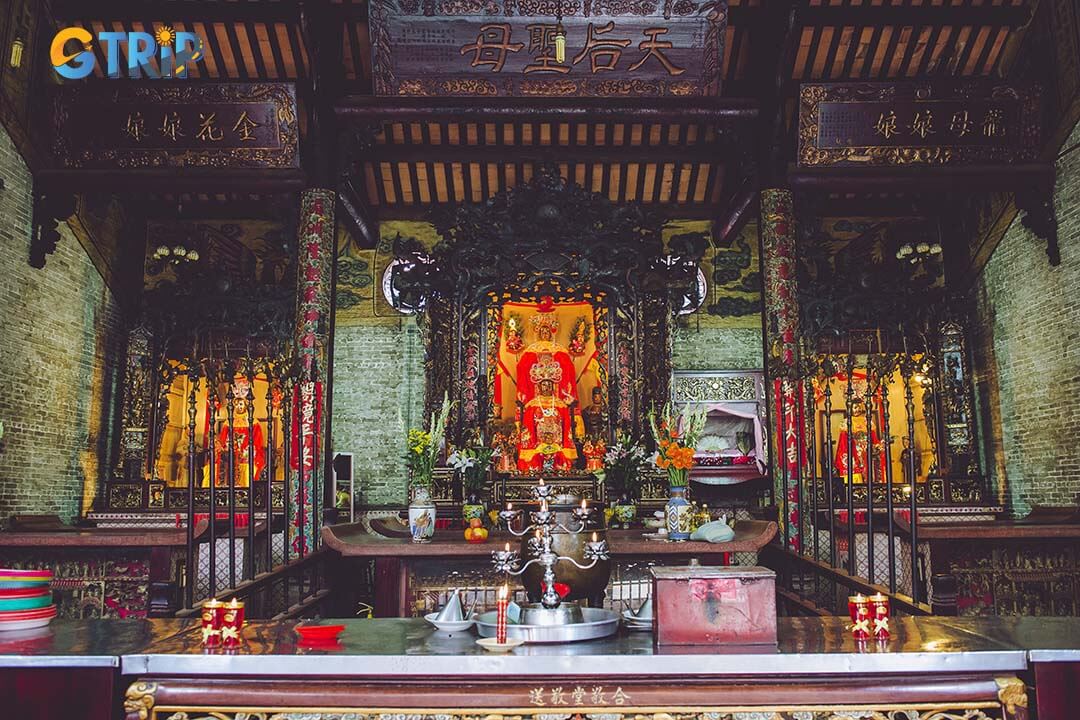
Thien Hau Pagoda showcases classic Chinese architecture, from its ornate “pai lou” entrance with dragon-carved columns to its harmonious courtyard layout
Intricate decorative details and symbolism
The decorative features of Thien Hau Pagoda are as compelling as its architecture. The roof of the pagoda is a spectacular sight, lined with ceramic figurines depicting mythical entities such as dragons, phoenixes, and celestial beings. These figures are not merely decorative but imbued with deep symbolism, each representing universal themes of harmony, prosperity, and protection.
The walls of the pagoda are adorned with colorful murals and frescoes, each telling stories of Mazu's legendary deeds. These vibrant depictions serve as visual narratives, preserving mythologies and inspiring spiritual reflection among devotees. Additionally, the intricate altar carvings and gilded motifs found throughout the temple highlight the craftsmanship honed through generations.
Such intricate details are a testament to the skilled artistry and devotion prevalent during the pagoda's construction. The use of traditional techniques and materials, like lacquer and gold leaf, further accentuates the authenticity and cultural significance of these decorations.
Unique features that attract visitors
Visitors are often astonished by the pagoda's exquisite ceramic dioramas, which adorn the roof and eaves of the main hall. These dioramas portray legendary battles and historical events, providing a vivid glimpse into the cultural narratives cherished by the temple community. The colorful scenes are crafted with remarkable precision, a feat that has fascinated architects and artisans alike.
Another distinctive feature of Thien Hau Pagoda is its incense-filled halls, where the air is thick with the fragrant smoke of burning incense coils. These coils, often intricately woven and hung from the ceilings, symbolize prayers spiraling toward the heavens. This mesmerizing sight, coupled with the hushed reverence of worshipers, creates a serene yet profound spiritual atmosphere.
Moreover, the pagoda's extensive use of stone carvings and calligraphy educates visitors about Confucian, Buddhist, and Taoist principles, firmly anchored in Chinese civilisation. The interplay of these religious symbols and artistry offers a unique opportunity for cultural appreciation and spiritual engagement.
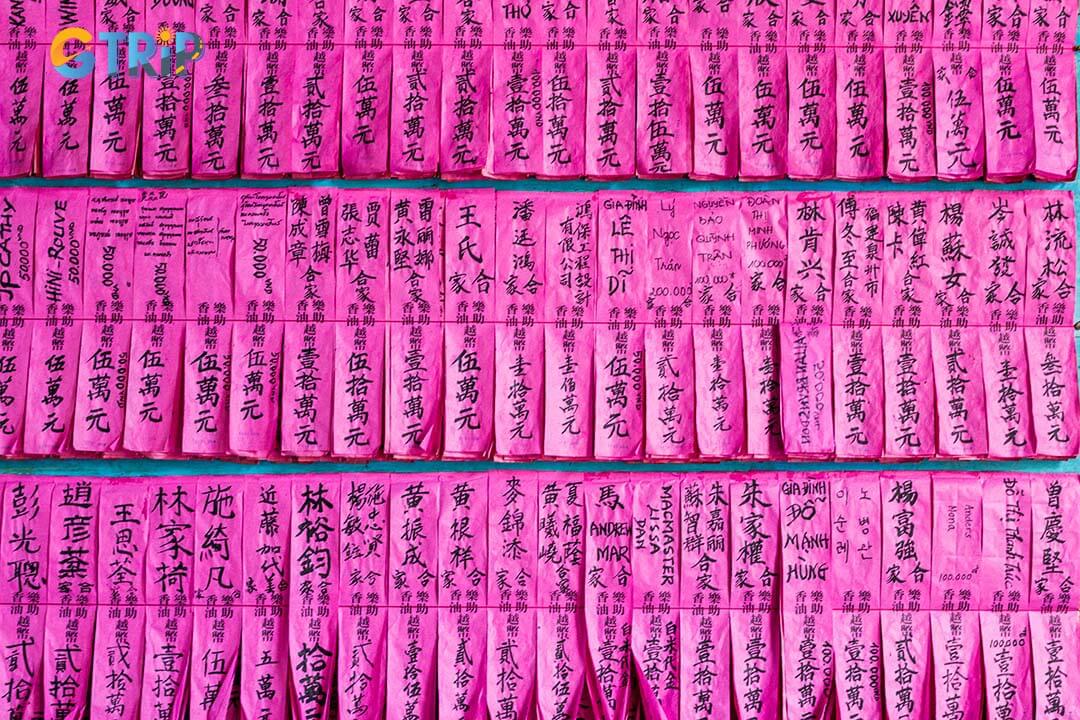
Thien Hau Pagoda captivates visitors with its intricate ceramic dioramas, fragrant incense coils, and detailed carvings
Thien Hau Pagoda's architecture and decor showcase Chinese artistry and deeply reflect its cultural and spiritual values. These elements collectively tell the story of a community's devotion, illustrating a seamless connection between heritage and identity. For visitors, both local and international, the pagoda provides an unparalleled insight into the harmonious blend of aesthetics and spirituality, forming an indispensable piece of Southeast Asian religious tourism.
Religious significance and worship practices
The Thien Hau Pagoda is not just a historical landmark, it is a vital spiritual hub reflective of the syncretic cultural and religious mosaic of Ho Chi Minh City. It embodying both traditional Chinese practices and local Vietnamese influences.
The Goddess Mazu and her role in local beliefs
The central figure of worship at Thien Hau Pagoda is Mazu, the sea goddess revered primarily by Chinese communities. Her presence is pivotal to the pagoda's religious significance. Mazu's mythology speaks to themes of protection and guidance, particularly over sailors and fishermen. This role as a protector is especially resonant in coastal communities and for those connected to the sea, which Taiwan and Southern China exemplify.
In Ho Chi Minh City, the veneration of Mazu transcends her maritime origins. The local ethnic Chinese, especially those with ancestral ties to Southern China, hold her in high esteem as a guardian deity. Her image within Thien Hau Pagoda is often surrounded by intricately carved dragon motifs and incense smoke, setting a profoundly spiritual ambiance. Pilgrims and visitors ask for Mazu's blessings for protection, prosperity, and good fortune, demonstrating her integration into broader community values.
Incense rituals and how to participate
Incense rituals form the cornerstone of worship practices at Thien Hau Pagoda. The ambiance of the pagoda is enriched by the sweet, musky fragrance of incense, which signifies the communication between the earthly and the divine. Participating in these rituals involves purchasing incense at the entrance, which is then offered at various altars within the temple complex.
The act of burning incense at Thien Hau is steeped in symbolism. It represents purification, the presence of divinity, and the prayers ascending to the heavens. Participants start by bowing three times before placing the incense sticks in large ornate burners.
Although visitors are welcome to partake in these rituals, it is essential to observe local customs, such as dressing modestly and maintaining silence to preserve the sanctity of the surroundings. Participating in this way offers a profound connection to the communal spirit and respect for Chinese religious traditions, even among those not of Chinese descent.
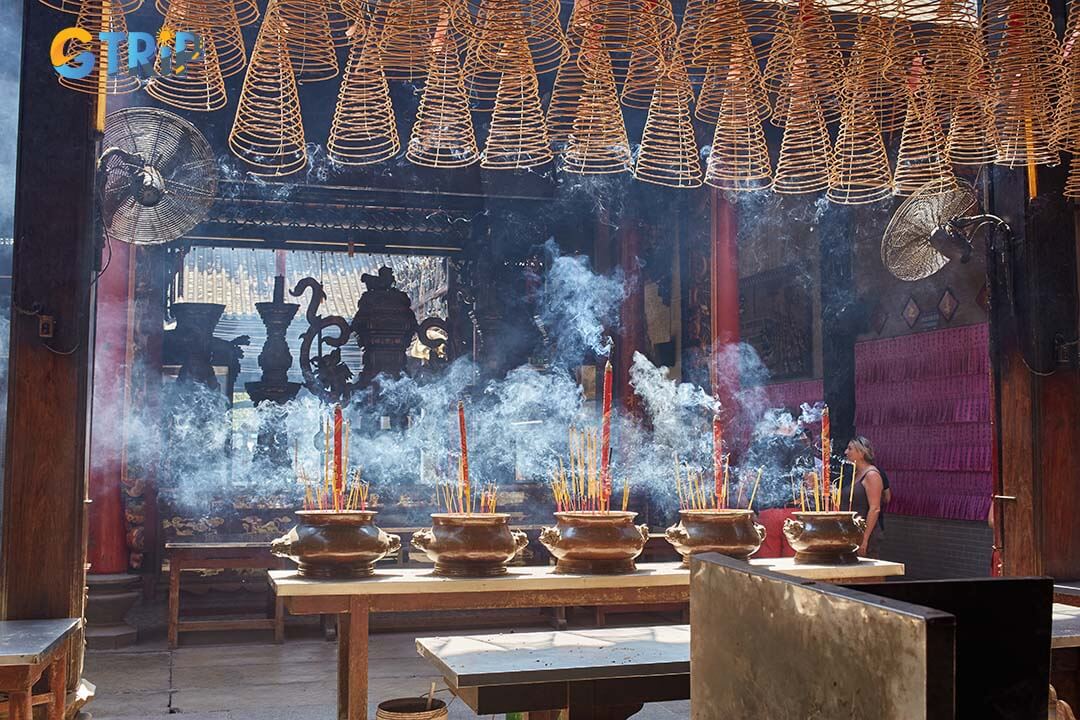
Incense rituals at Thien Hau Pagoda symbolize a sacred connection, offering visitors a serene experience of traditional Chinese spirituality
Community and worship center dynamics
Thien Hau Pagoda serves a dual role as a place of worship and a community anchor for the local Chinese-Vietnamese population. The pagoda's operations interweave cultural rituals with social gatherings, fostering a sense of solidarity. These dynamics are visible through community-driven events, which include festival preparations, charity endeavors, and cultural education, all conducted on the pagoda grounds.
Community leaders, often elders from the Chinese-Vietnamese community, play a crucial role in maintaining the religious and cultural vitality of Thien Hau Pagoda. Their efforts ensure the seamless integration of traditional practices with modern community needs. For instance, leadership committees organize annual events like the Lantern Festival and Chinese New Year, which emphasize continuity and communal joy.
Furthermore, the pagoda's function extends beyond religious observances. It offers a space for language preservation classes in Chinese dialects and Vietnamese, crucial for younger generations navigating dual cultural identities. Thus, Thien Hau Pagoda functions as a bastion of cultural heritage amid an evolving urban landscape.
Thien Hau Pagoda's religious significance is deeply rooted in its veneration of the goddess Mazu and the associated rituals that bridge spiritual and communal aspects of life in Cholon. If through incense offerings or community-oriented activities, the pagoda maintains its pivotal role as a spiritual nucleus that continues to nurture the cultural identities of those connected to it.
7 things to do at Thien Hau Pagoda
Thien Hau Pagoda is a remarkable cultural and spiritual landmark. It offers visitors a unique glimpse into the rich heritage of the Chinese-Vietnamese community, blending religious devotion with exquisite artistry. Here are seven meaningful activities you can enjoy when visiting this iconic pagoda:
1. Pray and make offerings
One of the primary reasons visitors come to Thien Hau Pagoda is to seek blessings from the goddess Thien Hau, who is revered as the protector of sailors and fishermen. Devotees light incense sticks and present offerings such as fresh fruits, flowers, and symbolic items like tea or rice wine at the altars. These offerings are expressions of respect and gratitude, believed to invite good fortune, health, and protection from harm. The atmosphere inside the pagoda is filled with the fragrant smoke of incense, creating a serene and contemplative environment.
2. Explore the architecture
Thien Hau Pagoda is a stunning example of traditional Southern Chinese architecture, reflecting the style brought by Cantonese immigrants centuries ago. The pagoda’s layout is carefully designed with three main halls front, central, and back, each serving different religious and cultural purposes. You can admire the intricate wood carvings on the beams and doors, the colorful ceramic mosaics and reliefs that depict legendary stories, and the majestic statues of deities.
The roof is adorned with porcelain figurines of dragons, phoenixes, and mythical creatures, which serve decorative purposes and symbolize protection and prosperity. The harmonious blend of wood, stone, and ceramic artistry creates a captivating visual experience that showcases the craftsmanship of past generations.
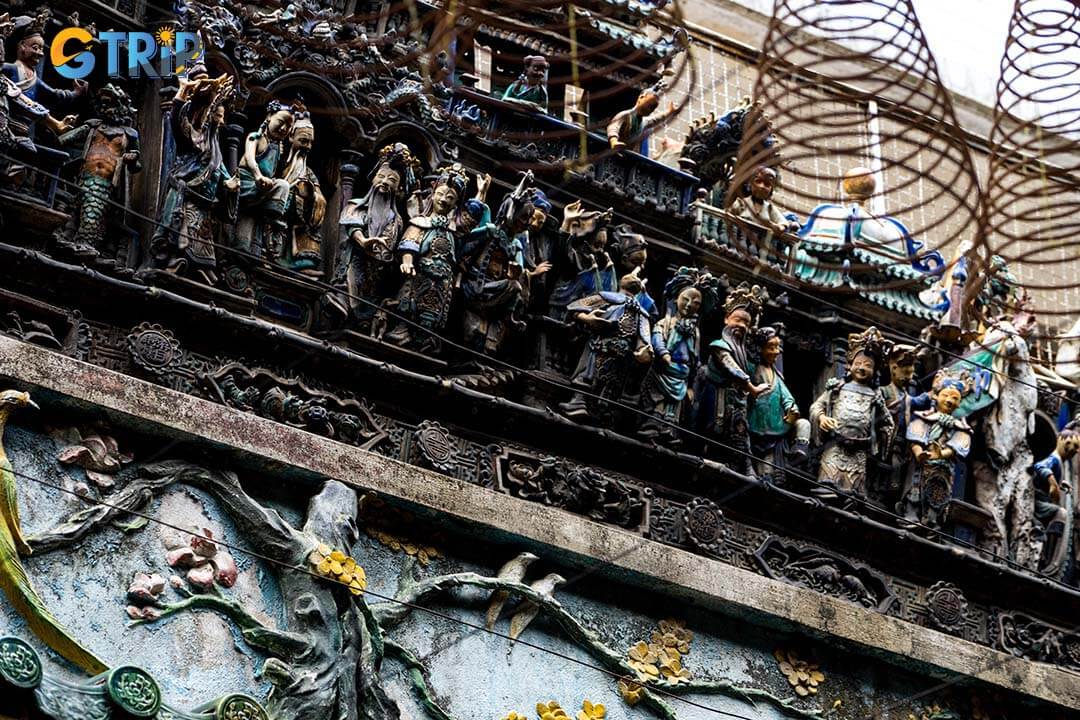
Thien Hau Pagoda features traditional Southern Chinese architecture with intricate wood carvings, ceramic mosaics, and symbolic porcelain figurines
3. Participate in festivals
The pagoda’s most vibrant time is during the annual festival celebrating the birthday of Thien Hau, held on the 23rd day of the third lunar month. This festival is one of the largest cultural events in Saigon’s Chinatown, drawing thousands of worshippers and tourists. The pagoda and surrounding streets are transformed with colorful lanterns, banners, and floral decorations.
Traditional lion and dragon dances enliven the atmosphere, accompanied by folk music and theatrical performances that narrate stories from Chinese mythology. The highlight is the grand procession where the statue of Thien Hau is carried through the neighborhood on a palanquin, accompanied by prayers, firecrackers, and chanting. This event is a spectacular display of faith, community spirit, and cultural pride.
4. Admire precious relics
Inside Thien Hau Pagoda, visitors have the rare opportunity to view a vast collection of nearly 400 antique artifacts that have been preserved for centuries. These include exquisitely carved wooden statues, stone incense burners, ancient bells, lacquered plaques, and stone steles inscribed with Chinese calligraphy. Many of these relics date back to the 18th and 19th centuries, reflecting the long history and devotion of the Chinese community in Saigon. The artefacts have religious significance and serve as valuable cultural treasures that tell stories about the community’s ancestry, beliefs, and artistic traditions. Guided tours or informational plaques help visitors appreciate the historical context and symbolism behind each piece.
5. Hang incense rings
A distinctive and memorable ritual at Thien Hau Pagoda is the hanging of large incense coils from the ceiling. You can purchase these incense rings, write their wishes or prayers on red ribbons attached to the coils, and then hang them inside the pagoda. As the incense slowly burns, it is believed that the smoke carries the prayers upward to the heavens, bridging the earthly world and the spiritual realm. This practice symbolizes hope, faith, and the desire for divine intervention in personal matters such as health, prosperity, and family harmony. The sight of dozens of glowing incense coils suspended in the air, filling the space with aromatic smoke, creates a mystical and deeply spiritual ambiance.
6. Capture iconic photos, especially during festivals
Thien Hau Pagoda is a favorite destination for photographers and cultural enthusiasts due to its striking architecture and atmospheric setting. Combining traditional Chinese design, colorful decorations, and swirling incense smoke offers countless opportunities for stunning photographs. During festivals, the pagoda bursts with color, traditional attire, and lively performances perfect for vibrant photos. Professional photographer or a casual visitor, capturing images here allows you to preserve the beauty and spirit of this historic site. These photos also serve as meaningful souvenirs that reflect the cultural diversity and spiritual depth of Ho Chi Minh City.
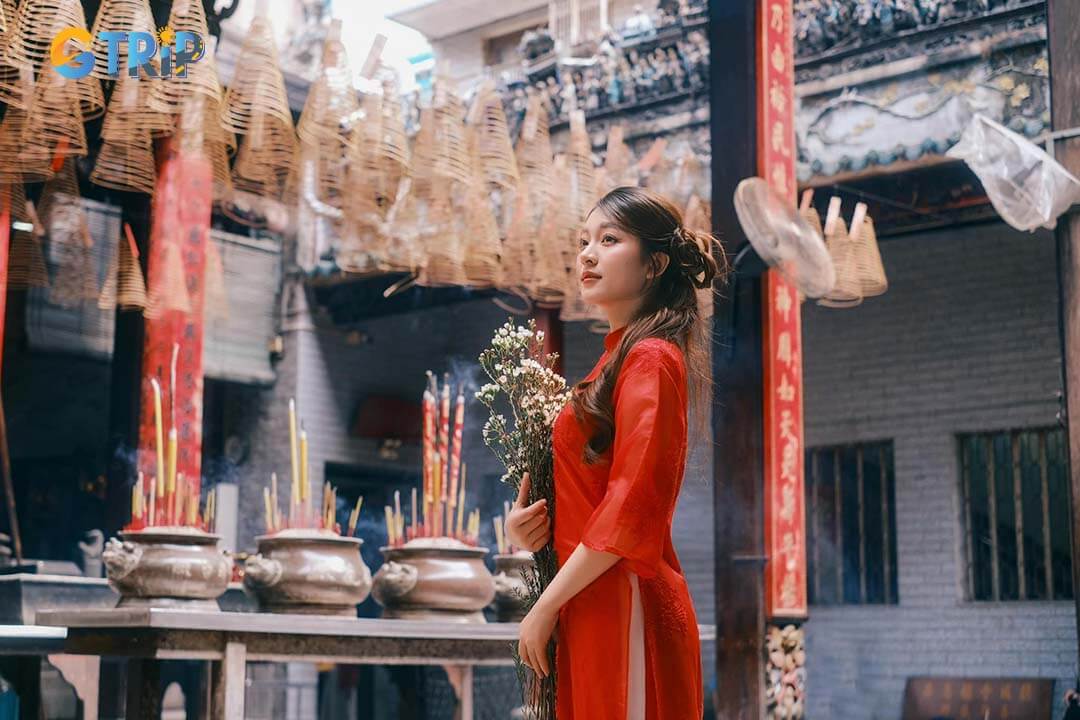
Thien Hau Pagoda offering stunning architectural shots and vibrant festival scenes, capturing the cultural and spiritual essence of Ho Chi Minh City
7. Draw fortune sticks
A meaningful and popular spiritual practice at Thien Hau Pagoda is kau cim, or drawing fortune sticks. Visitors can participate in this traditional ritual to seek guidance, blessings, and answers to personal questions about health, career, relationships, or prospects. The process involves shaking a container filled with numbered bamboo sticks until one falls out. Each number corresponds to a specific fortune or poem, which is then interpreted by temple staff or fortune tellers to provide insight and advice.
This ritual is deeply rooted in Chinese folk religion and is believed to connect the worshipper with divine wisdom. Many visitors find comfort and direction through their fortune readings, making kau cim a meaningful part of their visit. The pagoda often provides small booklets or explanations to help visitors understand their fortune’s message.
Participating in kau cim at Thien Hau Pagoda offers a unique cultural experience that combines faith, tradition, and personal reflection. It’s a wonderful way to engage with the spiritual atmosphere of the temple and gain a deeper understanding of the hopes and concerns of the local community.
Visiting Thien Hau Pagoda is more than just a sightseeing trip, it is an immersive cultural experience that connects you with centuries of tradition, faith, and artistry. If you come to pray, learn, celebrate, or simply admire, the pagoda offers a warm and welcoming atmosphere that leaves a lasting impression.
Festival highlights throughout the year
Thien Hau Pagoda, revered as a cultural and religious significance beacon, serves as a vibrant stage for many religious festivals that attract locals and tourists. These festivals celebrate the spiritual importance of Mazu and showcase the intricate blend of Chinese and Vietnamese cultures.
Major religious festivals and their significance
Key religious festivals at Thien Hau Pagoda include Thien Hau's Birthday Celebration, the Tet Nguyen Tieu (Lantern Festival), and the Vu Lan (Vu Lan Festival). Each holds distinct significance:
- Thien Hau's Birthday: Celebrated on the 23rd day of the third lunar month, this festival honors Mazu's benevolence and protection over seafarers. It involves elaborate processions, traditional music performances, and the offering of symbolic gifts and fruits. This festival underscores the community's deep faith in the goddess and their gratitude for her blessings.
- Tet Nguyen Tieu: Falling on the 15th day of the first lunar month, the Lantern Festival marks the end of Lunar New Year celebrations. It is particularly vibrant, with colorful lantern displays symbolizing the hope for a bright future. Rituals often include the release of lanterns to invite good fortune and health.
- Vu Lan (Ghost Festival): Observed during the seventh lunar month, this festival reflects the cultural interplay of Chinese respects and Vietnamese traditions. It is a time for honoring ancestors and liberating the souls of the deceased. Offerings, such as food and prayer, are made to seek peace and forgiveness for lost souls.
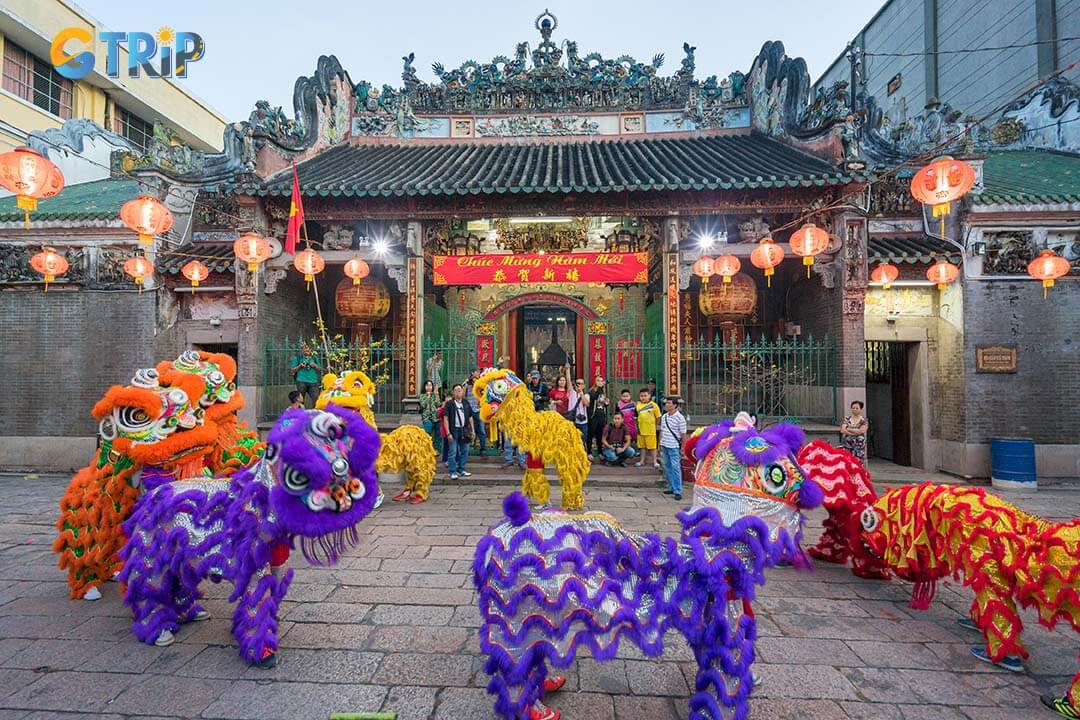
Key festivals at Thien Hau Pagoda include Thien Hau's Birthday, the Lantern Festival and the Ghost Festival, each celebrating faith, ancestors, and cultural traditions
How locals celebrate these events
Local celebrations during these festivals are both communal and family-centric. Residents participate in organizing parades and preparing the temple with intricate decorations. Public rituals involve chanting sutras, lighting incense, and presenting offerings on behalf of their families.
During Thien Hau's Birthday, the area around the pagoda becomes a bustling hub of festivities, with cultural performances, lion dances. These activities not only strengthen communal bonds but also reinforce the preservation of cultural heritage.
For Tet Nguyen Tieu, local families gather at the pagoda in traditional attire, carrying lanterns designed by family members. The night sky, illuminated by these lanterns, becomes a canvas of community wishes and aspirations.
Vu Lan sees locals tending to ancestral altars at home and participating in merit-making activities for ancestors. Many volunteer at communal kitchens, feeding monks and the needy, reflecting the festival's compassionate essence.
Tips for tourists wanting to participate
For tourists eager to experience these festivals, planning and etiquette are key. Here are a few tips:
- Plan your visit: Check the exact festival dates as they are based on the lunar calendar and can vary each year. Arriving early during festival days can provide the opportunity to witness the preparations and avoid the heaviest crowds.
- Respect cultural norms: Dress modestly, covering shoulders and knees, as a sign of respect when visiting the temple. Be mindful of temple etiquette—remove footwear before entering certain areas and refrain from pointing at religious icons.
- Engage with the community: Participate actively by joining in lantern parades or observing ritual performances. Respect and follow local directions during ceremonial activities, and don't hesitate to ask friendly locals or temple guides for information or guidance.
- Capture moments respectfully: Photography is generally allowed but always ask for permission before photographing rituals or individuals, especially during sacred ceremonies. Use discretion and avoid using flash.
Experiencing the festival highlights at Thien Hau Pagoda offers a profound glimpse into the cultural fabric of Ho Chi Minh City's Chinatown. Each celebration is an event of religious devotion and a vivacious portrayal of cultural endurance and community pride.
Best times to visit Thien Hau Pagoda
Planning a visit to Thien Hau Pagoda requires mindful consideration of local climate patterns. In Ho Chi Minh City, the peak tourist seasons coincide with dry weather, generally spanning from December to April. During these months, visitors can expect lower humidity levels and minimal rain, making outdoor exploration more comfortable. The average temperature hovers around 25-30°C, ideal for leisurely walks through the historical and cultural sites of Cholon, where Thien Hau Pagoda is located.
Alternatively, the months of May to November mark the rainy season, with the potential for heavy showers and high humidity. While some travelers might find the rains refreshing and the reduced tourist crowds appealing, it's important to note that sudden downpours can disrupt travel plans. Thus, an umbrella or raincoat becomes an essential item if visiting during this period.
How to get to Thien Hau Pagoda?
Thien Hau Pagoda is located at 710 Nguyen Trai Street, Ward 11, District 5, Ho Chi Minh City, in the heart of Chinatown (Cho Lon). It is a historic and spiritual site, easily accessible from the city center.
Taxi
- Taxi fares from central Ho Chi Minh City (District 1) to Thien Hau Pagoda typically range from 100,000 to 150,000 VND (approximately $4 to $6 USD) per trip, depending on traffic conditions and the taxi company (e.g., Mai Linh, Vinasun).
- Some sources mention fares around 150,000 VND ($6.5 USD) for the 20-30 minute journey from District 1 to Chinatown, where the pagoda is located.
- For private car rental or taxi with English-speaking drivers, prices can be higher, around $65 USD per day, but this is for a full-day rental rather than a single trip.
Motorbike Rental
- Renting a motorbike to visit Thien Hau Pagoda costs around 100,000 VND per day (about $4.3 USD), which is economical and flexible for exploring the city.
- Motorbike taxi fares for a single trip to the pagoda are about 50,000 VND (approximately $2.2 USD).
Ride-Hailing Apps (Grab, Go Viet)
- Ride-hailing services typically charge similar to taxis, around 100,000 to 150,000 VND ($4-$6 USD) for a trip from central districts to Thien Hau Pagoda, offering convenience and easy booking via smartphone apps.
Public Bus
- Bus routes 1, 56, and 150 pass near the pagoda. The bus fare is very low, about 6,000 VND (around $0.26 to $0.30 USD) per trip, making it the cheapest option though slower and less comfortable.
This makes visiting Thien Hau Pagoda accessible and straightforward whether you prefer private transport, local-style motorbiking, or app-based rides.
For a richer experience, consider joining guided Ho Chi Minh City tours to explore more cultural highlights alongside Thien Hau Pagoda.
Nearby attractions from Thien Hau Pagoda
Thien Hau Pagoda is surrounded by several vibrant and culturally rich attractions. These nearby spots offer visitors a deeper glimpse into the local lifestyle, traditional crafts, and bustling markets that define this historic area. If you’re looking to shop, explore colorful streets, or enjoy local cuisine, the following attractions are must-visit destinations within walking distance of the pagoda.
Hung Vuong Plaza (550 m)
Located at 126 Hong Bang Street in District 5, Hung Vuong Plaza is a dynamic commercial and entertainment complex that reflects the modern pulse of Chinatown. Just a short walk from Thien Hau Pagoda, this popular destination offers a wide range of activities for both shopping and dining. Inside, you’ll find various fashion boutiques, electronics stores, and a CGV cinema for movie lovers. For food enthusiasts, the plaza is home to several restaurants and food courts serving both local Vietnamese dishes and Chinese-Vietnamese specialties. A standout option is Haidilao Hot Pot, a well-known Chinese chain where you can enjoy a flavorful and interactive hot pot experience, a great way to explore cross-cultural cuisine.
Hung Vuong Plaza is especially vibrant in the evenings, when the area fills with locals and visitors, creating a bustling urban vibe. If you’re looking to shop, grab a bite, or simply soak in the energetic atmosphere, this plaza is an excellent stop to complement your visit to the historic pagoda nearby.
Luong Nhu Hoc Lantern Street
Luong Nhu Hoc Street is best known for its vibrant transformation during the Mid-Autumn Festival. While the street remains relatively quiet throughout most of the year, it truly comes alive as the holiday approaches. In the weeks before the festival, the street bursts with handcrafted lanterns of all shapes and colors, creating a vibrant, photo-worthy scene. This annual tradition showcases the creativity and cultural heritage of the Chinese-Vietnamese community in Cholon. At night, the glow from the lanterns creates a magical atmosphere, attracting both locals and tourists eager to experience the festive charm. Just a short walk from Thien Hau Pagoda, it's an ideal stop if you're visiting around Mid-Autumn and want to witness one of Saigon’s most beloved seasonal celebrations.
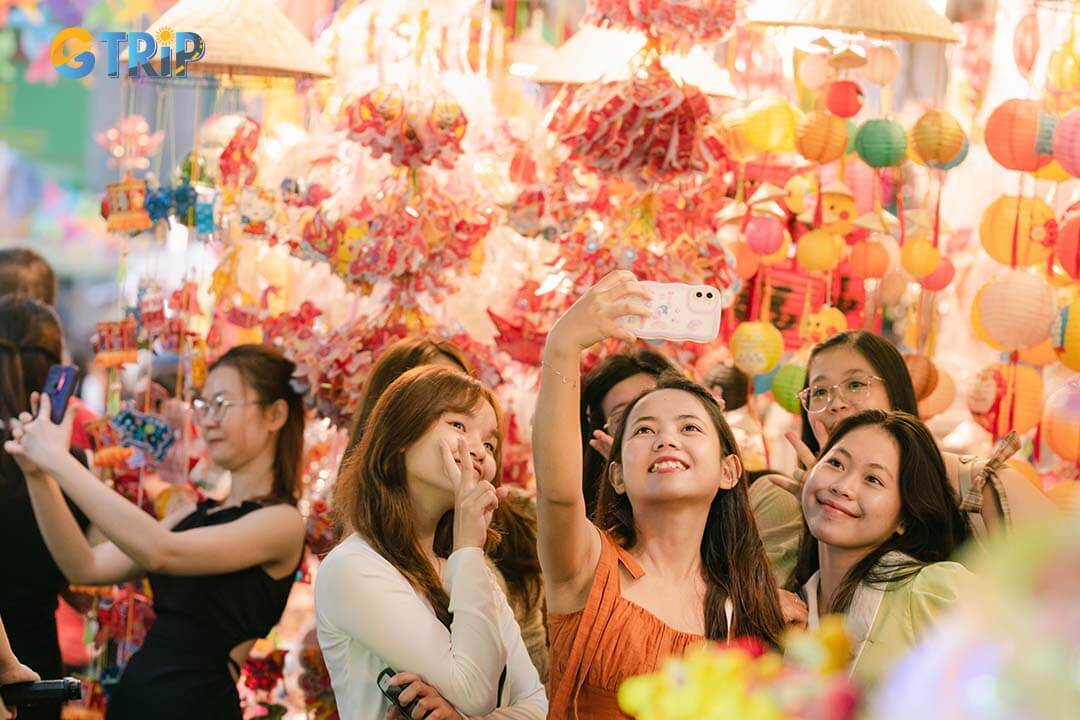
Luong Nhu Hoc Street lights up with dazzling lantern displays in the weeks before Mid-Autumn Festival, offering a magical
Phung Hung Market (450 m)
Phung Hung Market, located at 214 Phung Hung Street, District 5, is a vibrant traditional market just a short walk from Thien Hau Pagoda. Known for its authentic charm and local atmosphere, the market offers a diverse array of goods from fresh produce, seafood, and dried herbs to spices, fabric, clothing, and household essentials.
Beyond shopping, the market provides an opportunity to witness the everyday rhythm of life in Saigon’s Chinatown. The sound of lively bargaining, the aroma of freshly prepared street food, and the colorful stalls overflowing with goods create a dynamic and immersive experience. Looking to sample local snacks, buy unique ingredients, or simply soak in the culture, Phung Hung Market is a fantastic stop for travelers seeking a slice of authentic Vietnamese-Chinese daily life.
FAQS when visiting Thien Hau Pagoda
Visitors to Thien Hau Pagoda often come with many questions about this culturally significant site. Here, we address some of the most common inquiries to help enhance your understanding and preparation for your visit.
What is Thien Hau Pagoda?
Thien Hau Pagoda is a historic Chinese temple located in Cholon, the Chinatown of Ho Chi Minh City. It is dedicated to Mazu, the revered goddess of the sea, known for her protective qualities over sailors and fishermen.
Where is Thien Hau Pagoda located?
The pagoda is situated in former District 5 of Ho Chi Minh City, an area rich with cultural and historical relevance. It is easily accessible by public transportation, including buses and taxis.
Is photography allowed inside the pagoda?
Photography is generally allowed, but visitors are encouraged to be respectful, especially during religious ceremonies or when photographing individuals without permission. It is always best to ask a temple guide or staff member if you are unsure.
Thien Hau Pagoda offers a far more enriching experience when you’re equipped with key questions, practical tips, and helpful resources before your visit. Whether you’re fascinated by its intricate architecture, spiritual symbolism, or the deep cultural heritage it represents, these insights ensure a more respectful and meaningful journey. With support from GTrip, you can explore this historic sacred site with greater ease and appreciation.

